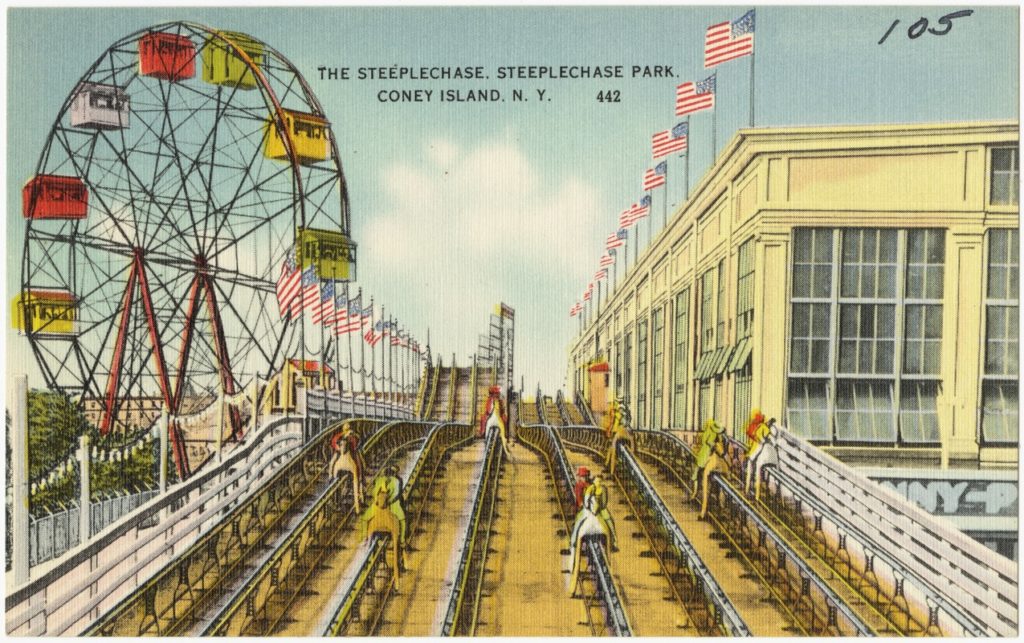In the shadow of the Parachute Jump, the last remnants of Coney Island’s first park, generations of visitors have walked along the Riegelmann Boardwalk, known as one of the longest in the world. Stretching for 4.3 km (2.7 miles), this seaside promenade was popularized in 1964 by The Drifters’ hit single “Under the Boardwalk”, which reached No. 4 on the Billboard Hot 100.
Just like this iconic song, Coney Island has cemented its place in American pop culture. Its rise began in the late 19th century, fueled by expanding railway networks that allowed the seaside resort to welcome up to two million visitors a year. Until World War II, it boasted the largest concentration of amusement attractions in the United States, with three legendary parks at its heart: Steeplechase Park, Luna Park, and Dreamland.

Steeplechase Park: The Beginning of the Golden Age
Steeplechase Park, named after its famous mechanical horse race, was the first amusement park on Coney Island. Its creator, George C. Tilyou, was fascinated by the Ferris wheel at the 1893 Chicago World’s Fair and was inspired to build his own, opening his park in 1897.
Over the decades, Steeplechase Park faced many challenges, including three fires within thirty years. Additionally, it had to contend with Coney Island’s growing reputation for vice, with gambling dens, prostitution, and gang activity spreading nearby.
When the 1939–1940 New York World’s Fair closed, Tilyou’s descendants discovered the famous Parachute Jump, a former parachutist training tower, and decided to purchase it. Today, this towering red structure – nicknamed the “Eiffel Tower of Brooklyn”– remains one of the last symbols of the park’s golden age. Listed on the National Register of Historic Places and designated a New York City Landmark, it is prominently featured in Joseph Heller’s nostalgic and semi-fantastical novel “Closing Time” (1994).
Luna Park: A Resurrection After Oblivion
The second waterfront icon, Luna Park, was opened in 1903 by Frederic Thompson and Helmer ‘Skip’ Dundy. One of its most famous attractions, A Trip to the Moon, originated at the 1901 Pan-American Exposition in Buffalo and inspired the park’s name, referencing its legendary spaceship Luna.
A dazzling and innovative place, Luna Park stood out for its spectacular lighting – an incredible feat for its time. But like Steeplechase, it suffered from an increasingly rough crowd and closed in 1944 after two devastating fires.
Dismantled in 1946, its legacy endured, inspiring the creation of numerous Luna Parks worldwide, including one in Paris, located at Porte Maillot until the 1940s. However, Luna Park’s story didn’t end there: in 2010, an ambitious revitalization campaign brought it back to life, restoring Coney Island’s amusement district to its former glory.

Dreamland: A Fleeting Dream
Although its existence was brief, Dreamland left a lasting mark on Coney Island’s history. Designed as a more refined and family-friendly alternative to the other parks, it opened in 1904 under the direction of William H. Reynolds and the Tammany Hall political machine. It was part of the trolley park concept, where transportation companies built amusement parks to encourage city dwellers to use their services on weekends.
Its visual spectacle was breathtaking: grandiose scenery illuminated by a million light bulbs transported visitors into a dreamlike world. The park featured roller coasters, a Venetian canal replica with gondola rides, and a famous “Lilliputian Village.” But, like many parks of the era, Dreamland struggled with structural issues. A fire – common in that period due to faulty electrical installations – completely destroyed the park in 1911. It was never rebuilt, and decades later, the site became home to the New York Aquarium.
As Kevin Baker describes in his historical novel Dreamland (1999), Coney Island is more than just an amusement park – it is a metaphor for the American dream, blending wonder and decline. Its lights, its endless innovations, and its legendary attractions have shaped a collective imagination that still resonates today. Though time has erased some of its former splendor, the spirit of Coney Island endures through its historic relics, its lively beach, and the nostalgia it continues to evoke.








